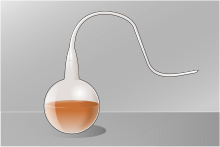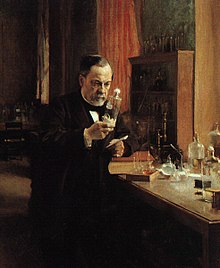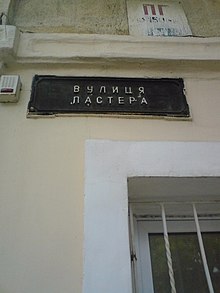From Wikipedia, the free encyclopedia
| Louis Pasteur | |
|---|---|

Photograph by Nadar
|
|
| Born | December 27, 1822 Dole, France |
| Died | September 28, 1895 (aged 72) Marnes-la-Coquette, France |
| Nationality | French |
| Fields | Chemistry Microbiology |
| Institutions | University of Strasbourg Lille University of Science and Technology École Normale Supérieure Pasteur Institute |
| Alma mater | École Normale Supérieure |
| Notable students | Charles Friedel[1] |
| Notable awards | Rumford Medal (1856, 1892) Copley Medal (1874) Albert Medal (1882) Leeuwenhoek Medal (1895) |
| Signature
|
|
Louis Pasteur (/ˈluːi pæˈstɜr/, French: [lwi pastœʁ]; December 27, 1822 – September 28, 1895) was a French chemist and microbiologist renowned for his discoveries of the principles of vaccination, microbial fermentation and pasteurization. He is remembered for his remarkable breakthroughs in the causes and preventions of diseases, and his discoveries have saved countless lives ever since. He reduced mortality from puerperal fever, and created the first vaccines for rabies and anthrax. His medical discoveries provided direct support for the germ theory of disease and its application in clinical medicine. He is best known to the general public for his invention of the technique of treating milk and wine to stop bacterial contamination, a process now called pasteurization. He is regarded as one of the three main founders of bacteriology, together with Ferdinand Cohn and Robert Koch, and is popularly known as the "father of microbiology".[2][3][4]
Pasteur was responsible for crushing the doctrine of spontaneous generation. He performed experiments that showed that without contamination, microorganisms could not develop. Under the auspices of the French Academy of Sciences, he demonstrated that in sterilized and sealed flasks nothing ever developed, and in sterilized but open flasks microorganisms could grow. This experiment won him the Alhumbert Prize of the academy.[5]
Pasteur also made significant discoveries in chemistry, most notably on the molecular basis for the asymmetry of certain crystals and racemization. He was the Director of the Pasteur Institute, established in 1887, till his death, and his body lies beneath the institute in a vault covered in depictions of his accomplishments in Byzantine mosaics.[6]
Although Pasteur made groundbreaking experiments, his reputation became associated with various controversies. Historical reassessment of his notebook revealed that he practiced deception to overcome his rivals.[7][8]
Early life
Louis Pasteur was born on December 27, 1822, in Dole, Jura, France, to a Catholic family of a poor tanner. He was the third child of Jean-Joseph Pasteur and Jeanne-Etiennette Roqui. In 1827, the family moved to Arbois, where he entered primary school in 1831. He was an average student in his early years, and not particularly academic, as his interests were fishing and sketching. His pastels and portraits of his parents and friends, made when he was 15, were later kept in the museum of the Pasteur Institute in Paris. In 1838, he left for Paris to join the Institution Barbet, but became homesick and returned in November. In 1839, he entered the Collège Royal de Besançon and earned his baccalauréat (BA) degree in 1840. He was appointed teaching assistant at the Besançon college while continuing a degree science course with special mathematics. He failed his first examination in 1841. He managed to pass the baccalauréat scientifique (general science) degree in 1842 from Dijon but with a poor grade in chemistry. After one failed attempt for the entrance test for the École Normale Supérieure in Paris in 1842, he succeeded in 1844. In 1845 he received the licencié ès sciences (Bachelor of Science) degree. In 1846, he was appointed professor of physics at the Collège de Tournon at Ardèche, but Antoine Jérome Balard (one of the discoverers of the element bromine) wanted him back at the École Normale Supérieure as a graduate assistant (préparateur) for chemistry courses. He joined Balard and simultaneously started his research in crystallography and in 1847, he submitted his two theses, one in chemistry and the other in physics. After serving briefly as professor of physics at the Dijon Lycée in 1848, he became professor of chemistry at the University of Strasbourg, where he met and courted Marie Laurent, daughter of the university's rector in 1849.
They were married on May 29, 1849, and together had five children, only two of whom survived to adulthood; the other three died of typhoid. These personal tragedies were his motivations for curing infectious diseases.[2][9]
Professional career
Pasteur was appointed to the Chair of Chemistry in the faculty of sciences of the University of Strasbourg in 1848. In 1854, he was named dean of the new faculty of sciences at Lille University, where he began his studies on fermentation.[10] It was on this occasion that Pasteur uttered his oft-quoted remark: "dans les champs de l'observation, le hasard ne favorise que les esprits préparés." (In the field of observation, chance favors only the prepared mind.[11])
In 1857, he moved to Paris as the director of scientific studies at the École Normale Supérieure where he took control from 1858 to 1867 and introduced a series of reforms to improve the standard of scientific work. The examinations became more rigid, which led to better results, greater competition, and increased prestige. Many of his decrees, however, were rigid and authoritarian, leading to two serious student revolts. During "the bean revolt" he decreed that a mutton stew, which students had refused to eat, would be served and eaten every Monday. On another occasion he threatened to expel any student caught smoking, and 73 of the 80 students in the school resigned.[12]
In 1862, he was appointed professor of geology, physics, and chemistry at the École nationale supérieure des Beaux-Arts, the position which held until his resignation in 1867. In Paris, he established the Pasteur Institute in 1887, in which he was its director for the rest of his life.[3][4][9]
Research contributions
Molecular asymmetry

Pasteur separated the left and right crystal shapes from each other to form two piles of crystals: in solution one form rotated light to the left, the other to the right, while an equal mixture of the two forms canceled each other's effect, and does not rotate the polarized light.
In Pasteur's early work as a chemist, beginning at the École Normale Supérieure, and continuing at Strasbourg and Lille, he examined the chemical, optical and crystallographic properties of a group of compounds known as tartrates.[13] He resolved a problem concerning the nature of tartaric acid (1848).[13][14][15][16][17] A solution of this compound derived from living things (specifically, wine lees) rotated the plane of polarization of light passing through it. The mystery was that tartaric acid derived by chemical synthesis had no such effect, even though its chemical reactions were identical and its elemental composition was the same.[18] Pasteur was able to show not only that optical activity related to the shape of the crystals, but also that an asymmetric internal arrangement of the molecules of the compound was responsible for twisting the light.[10] The (2R,3R)- and (2S,3S)- tartrates were isometric, non-superposable mirror images of each other. This was the first time anyone had demonstrated molecular chirality, and also the first explanation of isomerism.[13] Some historians consider Pasteur's work in this area to be his "most profound and most original contributions to science", and his "greatest scientific discovery."[13]
Fermentation and germ theory of diseases
Pasteur demonstrated that fermentation is caused by the growth of micro-organisms, and the emergent growth of bacteria in nutrient broths is due not to spontaneous generation, but rather to biogenesis (Omne vivum ex vivo "all life from life"). He was motivated to investigate the matter while working at Lille. In 1856 a local wine manufacturer, M. Bigot, the father of his student, sought for his advice on the problems of making beetroot alcohol and souring after long storage.[19] In 1857 he developed his ideas stating that: "I intend to establish that, just as there is an alcoholic ferment, the yeast of beer, which is found everywhere that sugar is decomposed into alcohol and carbonic acid, so also there is a particular ferment, a lactic yeast, always present when sugar becomes lactic acid."[20] According to his son-in-law, Pasteur presented his experiment on sour milk titled "Latate Fermentation" in August 1857 before the Société des Sciences de Lille. (But according to a memoire subsequently published, it was dated November 30, 1857).[21][22] It was published in full form in 1858.[23][24][25] He demonstrated that yeast was responsible for fermentation to produce alcohol from sugar, and that air (oxygen) was not required. He also demonstrated that fermentation could also produce lactic acid (due to bacterial contamination), which make wines sour. This is regarded as the foundation of Pasteur's fermentation experiment and disprove of spontaneous generation of life.While Pasteur was not the first to propose the germ theory (Girolamo Fracastoro, Agostino Bassi, Friedrich Henle and others had suggested it earlier, with an experimental demonstration by Francesco Redi in the 17th century), he developed it and conducted experiments that clearly indicated its correctness and managed to convince most of Europe that it was true. Today, he is often regarded as the father of germ theory.[26]
Pasteur's research also showed that the growth of micro-organisms was responsible for spoiling beverages, such as beer, wine and milk. With this established, he invented a process in which liquids such as milk were heated to a temperature between 60 and 100 °C.[27] This killed most bacteria and moulds already present within them. Pasteur and Claude Bernard completed the first test on April 20, 1862.[26] Pasteur patented the process, to fight the "diseases" of wine, in 1865.[27] The method became known as pasteurization, and was soon applied to beer and milk.[28]
Beverage contamination led Pasteur to the idea that micro-organisms infecting animals and humans cause disease. He proposed preventing the entry of micro-organisms into the human body, leading Joseph Lister to develop antiseptic methods in surgery. Lister's work in turn inspired Joseph Lawrence to develop his own alcohol-based antiseptic, which he named in tribute Listerine.[29]
In 1865, two parasitic diseases called pébrine and flacherie were killing great numbers of silkworms at Alais (now Alès). Pasteur worked several years proving that these diseases were caused by a microbe attacking silkworm eggs, and that eliminating the microbe in silkworm nurseries would eradicate the disease.[26]
Pasteur also discovered anaerobiosis, whereby some micro-organisms can develop and live without air or oxygen, called the Pasteur effect.
Spontaneous generation
Following his fermentation experiments, Pasteur demonstrated that the skin of grapes was the natural source of yeasts, and that sterilized grapes and grape juice never fermented. He drew grape juice from under the skin with sterilzed needles, and also covered grapes with sterilized cloth. Both experiments could not produce wine in sterilized containers. His findings and ideas were against the prevailing notion of spontaneous generation. He received a particularly stern criticism from Félix Archimède Pouchet, who was director of the Rouen Museum of Natural History. To settle the debate between the eminent scientists, the French Academy of Sciences offered Alhumbert Prize carrying 2,500 francs to who ever could experimentally demonstrate for or against the doctrine.[30][31][32]
To prove himself correct, Pasteur exposed boiled broths to air in swan-neck flasks that contained a filter to prevent all particles from passing through to the growth medium, and even in flasks with no filter at all, with air being admitted via a long tortuous tube that would not allow dust particles to pass. Nothing grew in the broths unless the flasks were broken open, showing that the living organisms that grew in such broths came from outside, as spores on dust, rather than spontaneously generated within the broth. This was one of the last and most important experiments disproving the theory of spontaneous generation for which Pasteur won the Alhumbert Prize in 1862. He concluded that:[33][34]
Never will the doctrine of spontaneous generation recover from the mortal blow of this simple experiment. There is no known circumstance in which it can be confirmed that microscopic beings came into the world without germs, without parents similar to themselves.
Immunology and vaccination
Pasteur's later work on diseases included work on chicken cholera. During this work, a culture of the responsible bacteria had spoiled and failed to induce the disease in some chickens he was infecting with the disease. Upon reusing these healthy chickens, Pasteur discovered he could not infect them, even with fresh bacteria; the weakened bacteria had caused the chickens to become immune to the disease, though they had caused only mild symptoms.[2][26]His assistant, Charles Chamberland (of French origin), had been instructed to inoculate the chickens after Pasteur went on holiday. Chamberland failed to do this, but instead went on holiday himself. On his return, the month-old cultures made the chickens unwell, but instead of the infections being fatal, as they usually were, the chickens recovered completely. Chamberland assumed an error had been made, and wanted to discard the apparently faulty culture when Pasteur stopped him. Pasteur guessed the recovered animals now might be immune to the disease, as were the animals at Eure-et-Loir that had recovered from anthrax.[35]
In the 1870s, he applied this immunization method to anthrax, which affected cattle, and aroused interest in combating other diseases.
Pasteur publicly claimed he had made the anthrax vaccine by exposing the bacilli to oxygen. His laboratory notebooks, now in the Bibliothèque Nationale in Paris, in fact show that he used the method of rival Jean-Joseph-Henri Toussaint, a Toulouse veterinary surgeon, to create the anthrax vaccine.[18][36] This method used the oxidizing agent potassium dichromate. Pasteur's oxygen method did eventually produce a vaccine but only after he had been awarded a patent on the production of an anthrax vaccine.
The notion of a weak form of a disease causing immunity to the virulent version was not new; this had been known for a long time for smallpox. Inoculation with smallpox was known to result in far less scarring, and greatly reduced mortality, in comparison with the naturally acquired disease. Edward Jenner had also discovered vaccination using cowpox to give cross-immunity to smallpox in 1796, and by Pasteur's time this had generally replaced the use of actual smallpox material in inoculation. The difference between smallpox vaccination and anthrax or chicken cholera vaccination was that the weakened form of the latter two disease organisms had been "generated artificially", so a naturally weak form of the disease organism did not need to be found. This discovery revolutionized work in infectious diseases, and Pasteur gave these artificially weakened diseases the generic name of "vaccines", in honour of Jenner's discovery. Pasteur produced the first vaccine for rabies by growing the virus in rabbits, and then weakening it by drying the affected nerve tissue.[37]
The rabies vaccine was initially created by Emile Roux, a French doctor and a colleague of Pasteur who had been working with a killed vaccine produced by desiccating the spinal cords of infected rabbits. The vaccine had been tested in 50 dogs before its first human trial.[38][39] This vaccine was first used on 9-year old Joseph Meister, on July 6, 1885, after the boy was badly mauled by a rabid dog.[18][37] This was done at some personal risk for Pasteur, since he was not a licensed physician and could have faced prosecution for treating the boy. After consulting with colleagues, he decided to go ahead with the treatment. Three months later he examined Meister and found that he was in good health.[40] Pasteur was hailed as a hero and the legal matter was not pursued. The treatment's success laid the foundations for the manufacture of many other vaccines. The first of the Pasteur Institutes was also built on the basis of this achievement.[18]
Legal risk was not the only kind Pasteur undertook. In The Story of San Michele, Axel Munthe writes of the rabies vaccine research:
Pasteur himself was absolutely fearless. Anxious to secure a sample of saliva straight from the jaws of a rabid dog, I once saw him with the glass tube held between his lips draw a few drops of the deadly saliva from the mouth of a rabid bull-dog, held on the table by two assistants, their hands protected by leather gloves.Because of his study in germs, Pasteur encouraged doctors to sanitize their hands and equipment before surgery. Prior to this, few doctors or their assistants practiced these procedures.
Pasteur Institute
The Pasteur Institute was established by Pasteur to perpetuate his commitment to basic research and its practical applications. He brought together scientists with various specialties. The first five departments were directed by two normaliens (graduates of the École Normale Supérieure): Emile Duclaux (general microbiology research) and Charles Chamberland (microbe research applied to hygiene), as well as a biologist, Ilya Ilyich Mechnikov (morphological microbe research) and two physicians, Jacques-Joseph Grancher (rabies) and Emile Roux (technical microbe research). One year after the inauguration of the institute, Roux set up the first course of microbiology ever taught in the world, then entitled Cours de Microbie Technique (Course of microbe research techniques). Since 1891 the Pasteur Institute had been extended to different countries, and currently there are 32 institutes in 29 countries in various parts of the world.[41]Faith and spirituality
His grandson, Louis Pasteur Vallery-Radot, wrote that Pasteur had only kept from his Catholic background a spiritualism without religious practice,[42] although Catholic observers often said Louis Pasteur remained throughout his whole life an ardent Christian, and his son-in-law, in perhaps the most complete biography of Louis Pasteur, writes:Absolute faith in God and in Eternity, and a conviction that the power for good given to us in this world will be continued beyond it, were feelings which pervaded his whole life; the virtues of the gospel had ever been present to him. Full of respect for the form of religion which had been that of his forefathers, he came simply to it and naturally for spiritual help in these last weeks of his life.[43]Maurice Vallery-Radot, grandson of the brother of the son-in-law of Pasteur and outspoken Catholic, also holds that Pasteur fundamentally remained Catholic.[44] According to both Pasteur Vallery-Radot and Maurice Vallery-Radot, the following well-known quotation attributed to Pasteur is apocryphal:[45] "The more I know, the more nearly is my faith that of the Breton peasant. Could I but know all I would have the faith of a Breton peasant's wife".[2] According to Maurice Vallery-Radot,[46] the false quotation appeared for the first time shortly after the death of Pasteur.[47]
However, despite his belief in God, it has been said that his views were that of a freethinker rather than a Catholic, a spiritual more than a religious man.[48][49][50] He was also against mixing science with religion.[51][52]
Principal works
Pasteur's principal works are:[2]| French Title | Year | English Title |
|---|---|---|
| Etudes sur le Vin | 1866 | Studies on Wine |
| Etudes sur le Vinaigre | 1868 | Studies on Vinegar |
| Etudes sur la Maladie des Vers à Soie (2 volumes) | 1870 | Studies on Silk Worm Disease |
| Quelques Réflexions sur la Science en France | 1871 | Some Reflections on Science in France |
| Etudes sur la Bière | 1876 | Studies on Beer |
| Les Microbes organisés, leur rôle dans la Fermentation, la Putréfaction et la Contagion | 1878 | Microbes organized, their role in fermentation, putrefaction and the Contagion |
| Discours de Réception de M.L. Pasteur à l'Académie française | 1882 | Speech by Mr L. Pasteur on reception to the Académie française |
| Traitement de la Rage | 1886 | Treatment of Rabies |
Honours and final days
Pasteur was frequently struck by strokes since 1868, and the one in 1894 severely impaired his health. Failing to fully recover from the shock, he died in 1895, near Paris.[18] He was given a state funeral and was buried in the Cathedral of Notre Dame, but his remains were reinterred in a crypt in the Pasteur Institute in Paris, where the crypt is engraved with his life-saving works.He was awarded the prize of 1,500 francs in 1853 by the Pharmaceutical Society for the synthesis of racemic acid. In 1856 the Royal Society of London presented him the Rumford Medal for his discovery of the nature of racemic acid and its relations to polarized light, and the Copley medal in 1874 for his work on fermentation. The French Academy of Sciences awarded him the Montyon Prizes in 1859 for experimental physiology, and the Jecker Prize in 1861 and the Alhumbert Prize in 1862 for his experimental refutation of spontaneous generation. Though he lost election in 1857 for membership to the French Academy of Sciences, he won it in 1862 in mineralogy section, and was appointed to permanent secretary of the physical science section of the academy in 1887. In 1873 he was elected to the Académie Nationale de Médecine. He was elected to Littré's seat at the Académie française in 1881.
In 1873 he was made the commander in the Brazilian Order of the Rose.
Pasteur won the Leeuwenhoek medal, microbiology's highest Dutch honor in Arts and Sciences, in 1895. Both the Institute Pasteur and Université Louis Pasteur were named after him.
He was made a Chevalier or Knight of the Legion of Honour in 1853, promoted to Commander in 1868, to Grand Officer in 1878 and made a Grand Croix of the Legion of Honor – one of only 75 in all of France - in 1881.[9]
On June 8, 1886, the Ottoman Sultan Abdul Hamid II awarded Pasteur with the Order of the Medjidie (I Class) and 10000 Ottoman liras.[54]
Legacy
In many localities worldwide, streets are named in his honor. For example, in the USA: Palo Alto and Irvine, California, Boston and Polk, Florida, adjacent to the University of Texas Health Science Center at San Antonio; Jonquière, Québec; San Salvador de Jujuy and Buenos Aires (Argentina), Great Yarmouth in Norfolk, in the United Kingdom, Jericho and Wulguru in Queensland, (Australia); Phnom Penh in Cambodia; Ho Chi Minh City; Batna in Algeria; Bandung in Indonesia, Tehran in Iran, near the central campus of the Warsaw University in Warsaw, Poland; adjacent to the Odessa State Medical University in Odessa, Ukraine; Milan in Italy and Bucharest, Cluj-Napoca and Timișoara in Romania. The Avenue Pasteur in Saigon, Vietnam, is one of the few streets in that city to retain its French name.
Avenue Louis Pasteur in the Longwood Medical and Academic Area in Boston, Massachusetts was named in his honor in the French manner with "Avenue" preceding the name of the dedicatee.[55]
The Lycée Pasteur in Neuilly-sur-Seine, France, Lycée Louis Pasteur in Calgary, Canada and a large university hospital in Košice, Slovakia are also named after him.
His statue is erected at San Rafael High School in San Rafael, California.
A bronze bust of Pasteur resides on the French Campus of Kaiser Permanente's San Francisco Medical Center in San Francisco, California. The sculpture was designed by Harriet G. Moore and cast in 1984 by Artworks Foundry.[56]
The UNESCO/Institut Pasteur Medal was created on the centenary of Pasteur's death, and is given every two years in his name, "in recognition of outstanding research contributing to a beneficial impact on human health".[57]








